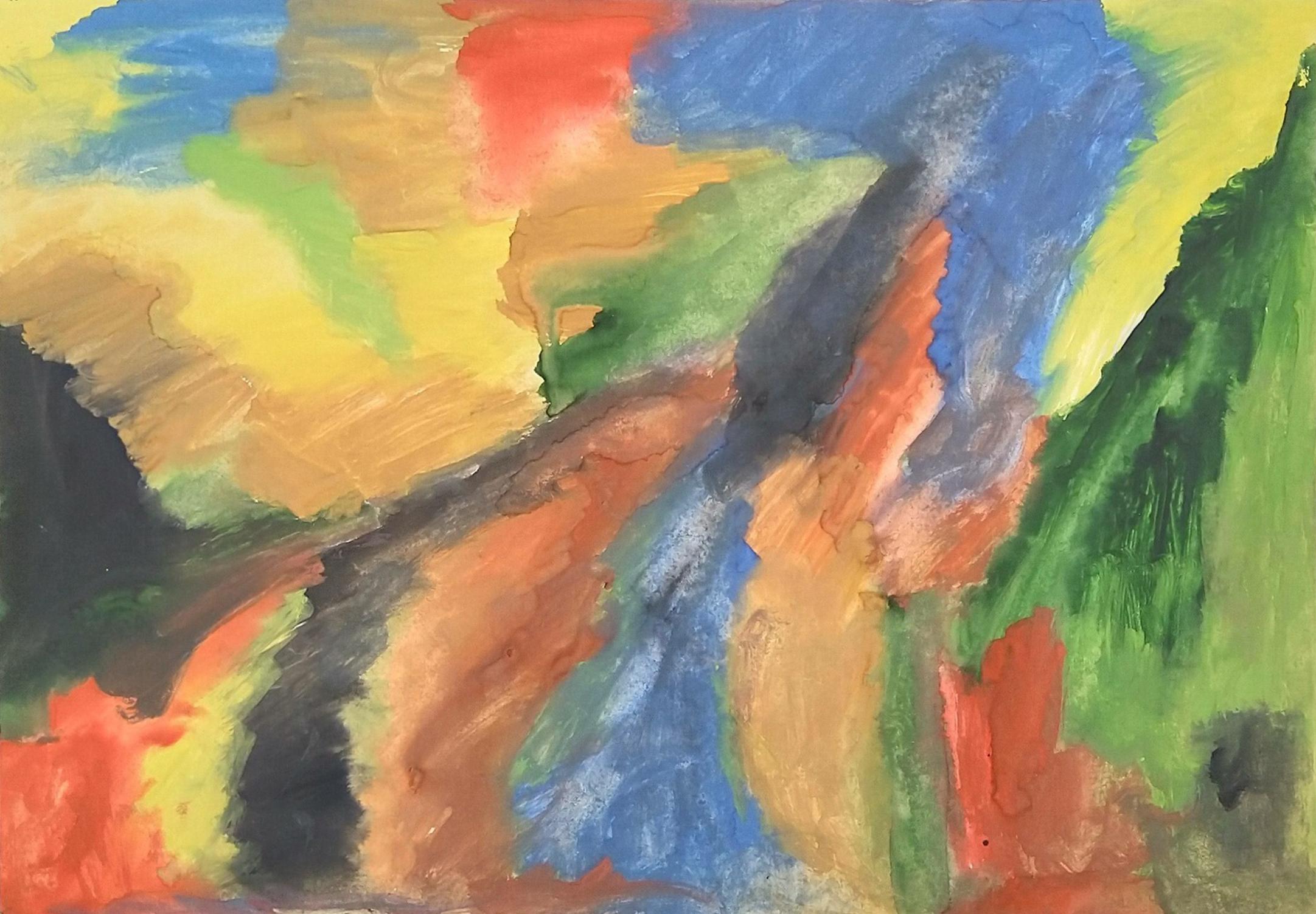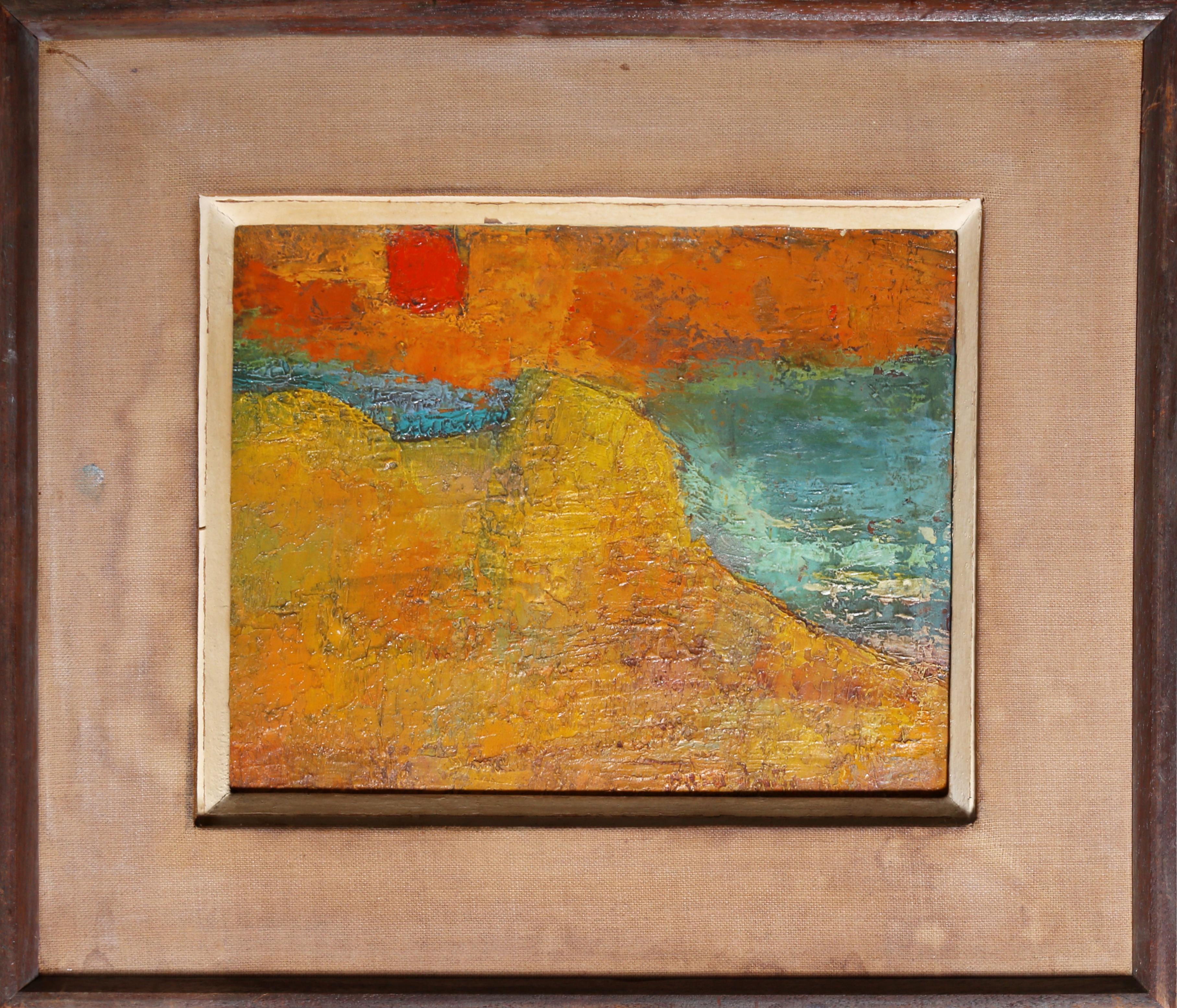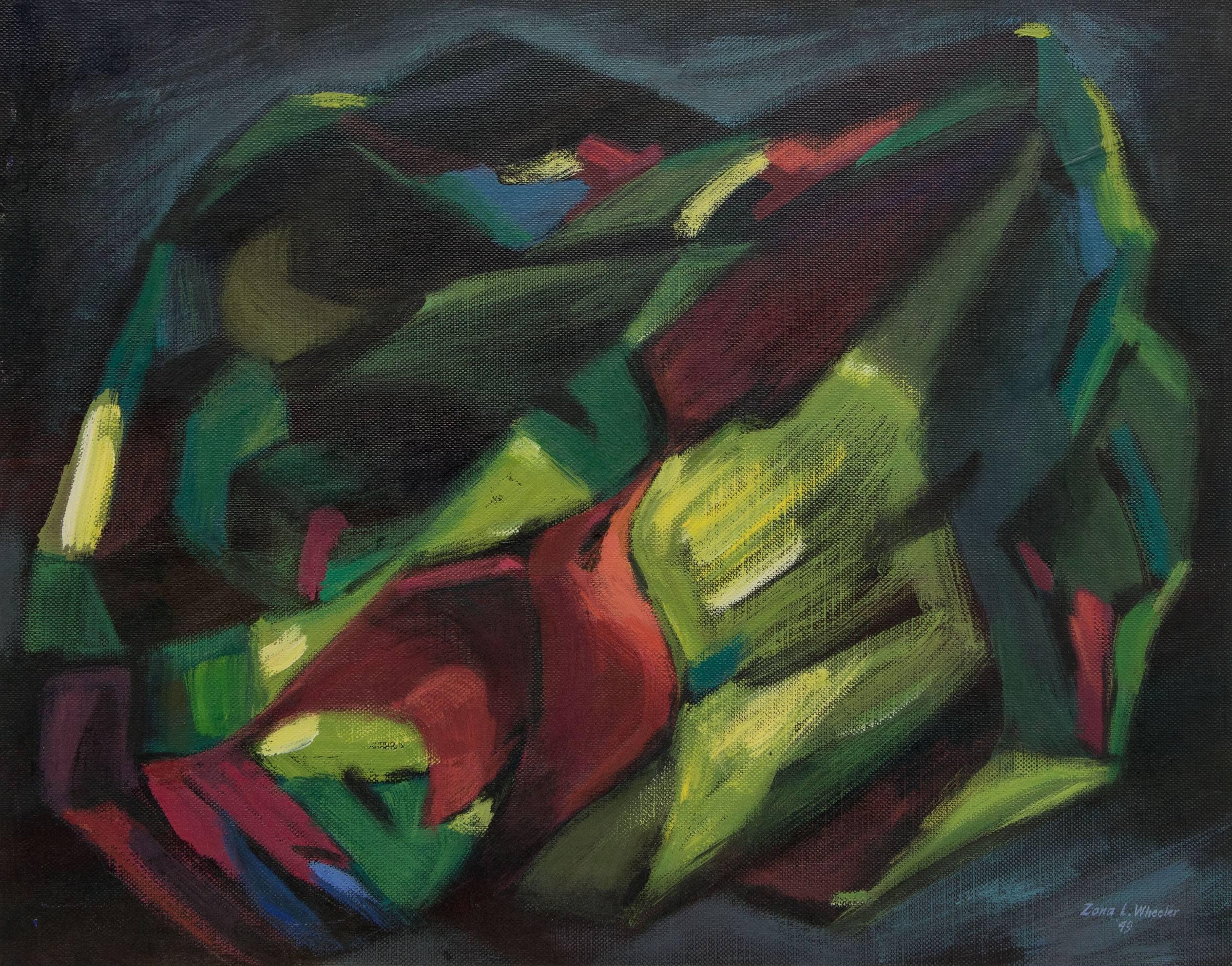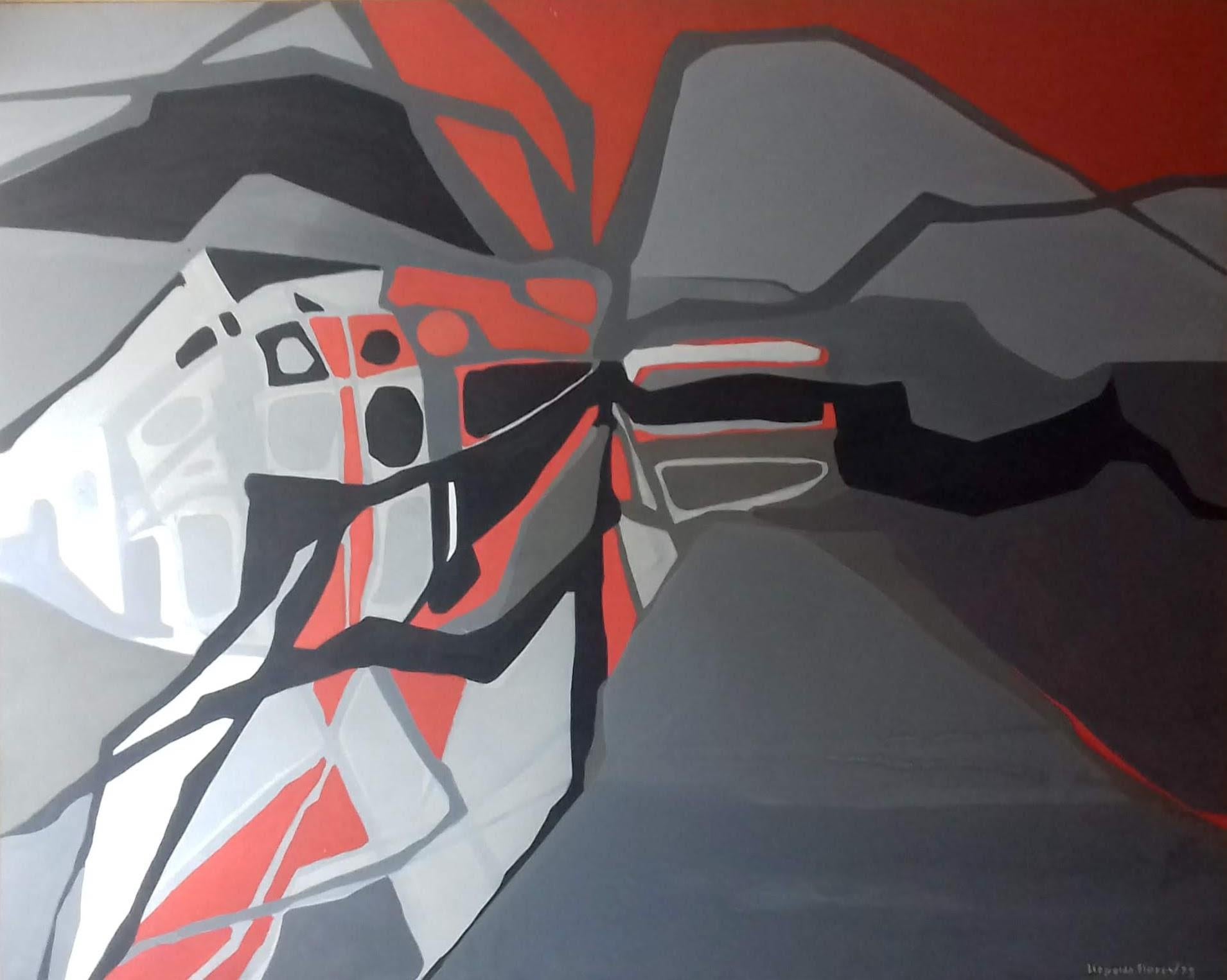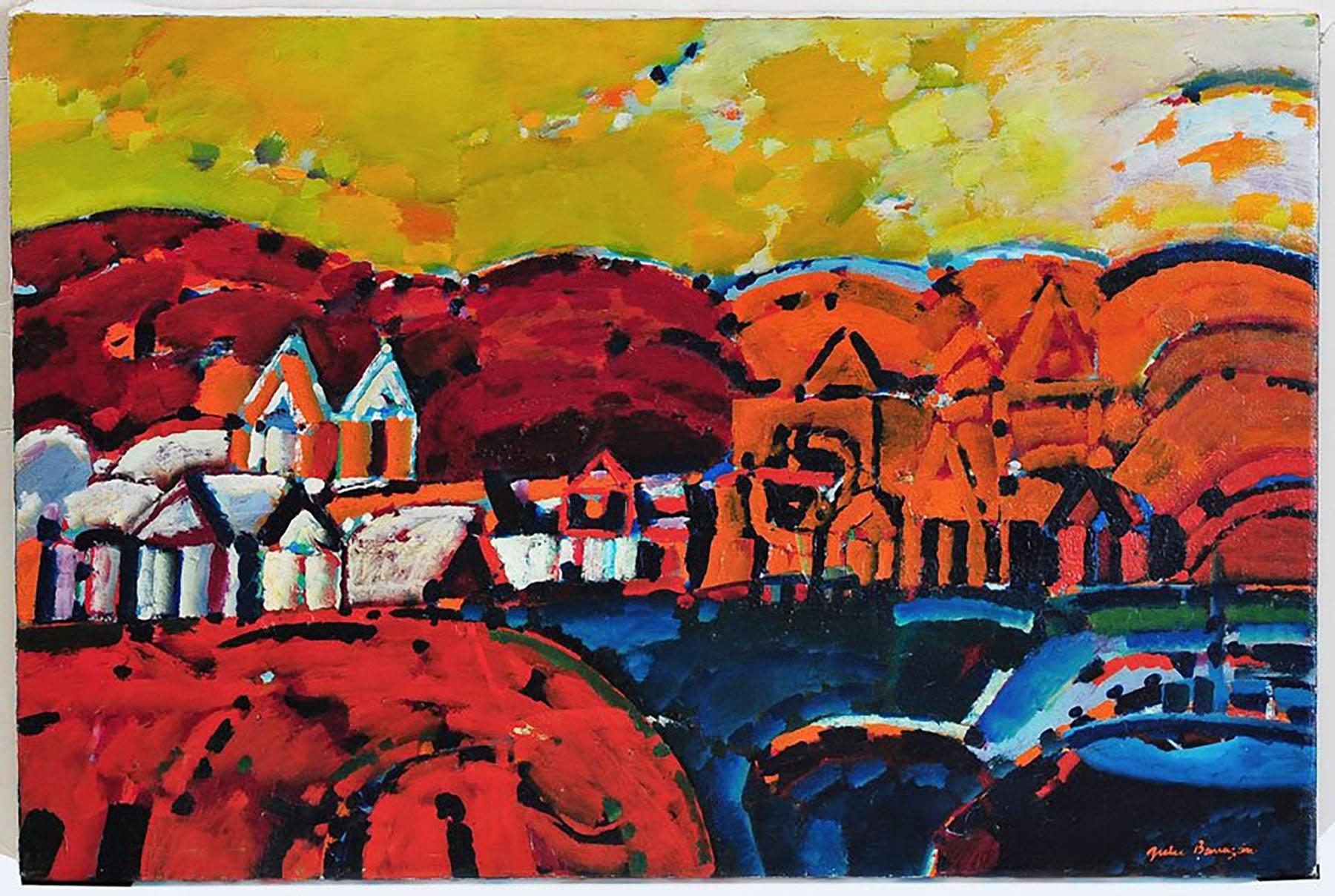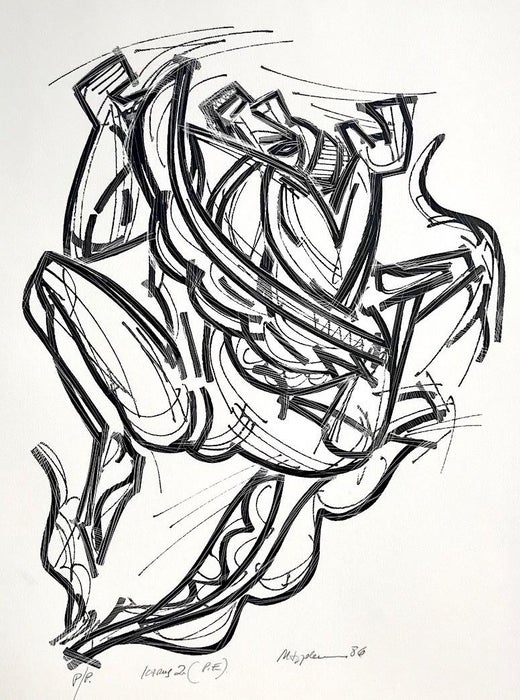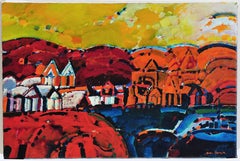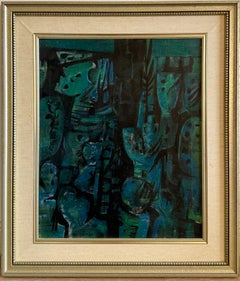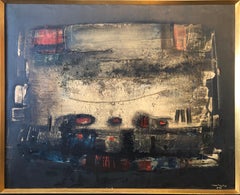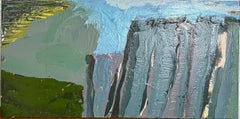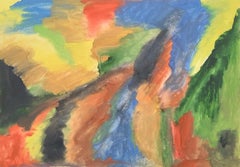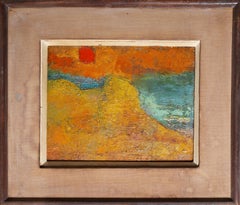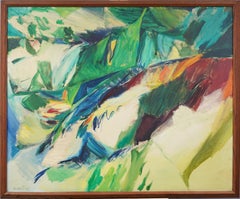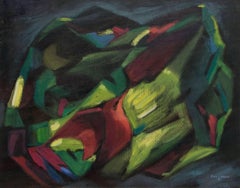Items Similar to Large Venezuelan Modernist Abstract Oil Painting Machu Picchu Marius Sznajderman
Want more images or videos?
Request additional images or videos from the seller
1 of 12
Marius SznajdermanLarge Venezuelan Modernist Abstract Oil Painting Machu Picchu Marius Sznajderman1983
1983
$2,800
£2,171.04
€2,463.45
CA$4,013.68
A$4,364.31
CHF 2,299.56
MX$53,013.64
NOK 28,910.15
SEK 27,100.93
DKK 18,486.03
About the Item
Marius Sznajderman
Hand signed and dated lower right, with an inscription on the verso
40 X 30 inches
Oil or acrylic on canvas.
Machu Picchu is an Incan citadel set high in the Andes Mountains in Peru, above the Urubamba River valley. Built in the 15th century and later abandoned. The lost city of the Incas.
Expressively capturing the mystique of the famed Incan ruins, this 1983 exprerssionist painting by Marius Sznajderman, titled Machu Picchu Courtyard, showcases his signature blend of bold color and dynamic brushwork. The composition features a stylized interpretation of Machu Picchu's verdant landscape and ancient stone structures, rendered in an abstracted yet recognizable form. Sznajderman's use of undulating greens, deep blues, and earthy tones imbues the work with an almost dreamlike quality, emphasizing the spiritual and historical significance of the site. Marius Sznajderman was a French-born American painter, printmaker, and scenic designer. Born in Paris in 1926 to Polish-Jewish parents, he fled Nazi-occupied France in 1942, eventually settling in Caracas, Venezuela. There, he studied at the School of Fine Arts and co-founded the Taller Libre de Arte, an influential experimental art workshop. In 1949, he immigrated to the United States, earning both Bachelor and Master of Fine Arts degrees from Columbia University. Over his extensive career, Sznajderman explored themes ranging from Latin American culture to Jewish heritage, with his works held in numerous public collections, including the Smithsonian Institution and the Museum of Modern Art in New York.
Artist: Marius Sznajderman (French-American, 1926-2018)
Issued: 1983
Dimensions: 41"L x 31"H
Country of Origin: France/United States
Marius Sznajderman was a Jewish Venezuelan painter, printmaker and scenic designer living and working in the United States.
Born in Paris, France in 1926 his Jewish parents had migrated to France from Poland in 1923. In November 1942 the family fled Nazi-occupied France for Spain before settling in Caracas, Venezuela. He attended the School of Fine Arts in Caracas where his teachers included illustrator Ramon Martin Durban, scenic designer Charles Ventrillon-Horber and painter Rafael Monasterios. and immigrated to the United States in 1949, where he received a Bachelor of Fine Arts and Master of Fine Arts from Columbia University in New York. He settled in Hackensack, New Jersey, where he lived and had a studio for more than 50 years before moving to Amherst, Massachusetts in 2015. His work, which includes painting, prints and collages, as well as set designs, is in more than 45 museum and public institution collections in the United States, Latin America and Israel. He held more than 40 solo exhibitions at galleries and museums and participated in more than 75 group shows around the globe.
He helped found the Taller Libre de Arte, an experimental workshop for the visual arts, sponsored by the Ministry of Education. The Taller Libre de Arte was a center for young artists to work and to meet with critics and intellectuals to discuss avant-garde ideas and artistic trends from Europe and Latin America. Among the notable artists who participated in the Taller Libre de Arte were Ramón Vásquez Brito, Carlos González Bogen, Luis Guevara Moreno, Mateo Manaure, Virgilio Trómpiz, Alirio Oramas, Dora Hersen, Alejandro Otero, Jesús Rafael Soto, Pascual Navarro, Aimée Battistini, José Fernández Díaz, Narciso Debourg, Oswaldo Vigas and Perán Erminy.
Sznajderman’s early works as a student and young artist showed the influence of Cubism and Expressionism with subject matter ranging from figures to still life to Venezuelan landscapes. His work often explored Latin American themes, art and architecture.
In 1948 Sznajderman was awarded the art student’s prize for a watercolor in the annual National Gallery exhibit. In 1949 Sznajderman had a solo exhibition at the Taller Libre de Arte. The exhibit catalogue was written by Sergio Antillano, a prominent Venezuelan writer and critic.
That same year, Sznajderman immigrated to the United States to attend Columbia University, where he studied with scenic designer J. Woodman Thompson and printmaker Hans Alexander Mueller. He received a Bachelor of Science degree with a major in scenic design in 1953, after which he was drafted into the U.S. Army. In the military he worked as an artist-illustrator, completing his service in 1955. He returned to Columbia on the G.I Bill to attend Teachers College, where he received a Master of Fine Arts in art education.
During the 1950s Sznajderman created set designs for Circle in the Square Theatre, the French Art Theatre and the Felix Fibich Dance Company, all in New York. By the late 1950s, however, his focus was shifting to fine arts and teaching.
In 1960 Sznajderman was among the three founders, along with painters Sam Weinik and Ben Wilson, of the Modern Artists Guild (MAG), an association of modern artists working in northern New Jersey. Among the artists who were early members of MAG were Esther Rosen, Alexandra Merker, Erna Weill, Jerry Goldman, Lillian Marzell and Evelyn Wilson.
In the 1950s, 1960s and 1970s, in addition to painting and printmaking, Sznajderman taught art, art history and design at a number of institutions including New York University, the School of Visual Arts, Fairleigh Dickinson University and the Ridgewood (N.J.) School of Art. He also taught art in New Jersey public schools under federal and state grants. During this period, Sznajderman’s work ranged from drawings, woodcuts and lithographs to watercolor and acrylic paintings and collages. He produced still life, figures, landscapes and seascapes. Inspirations included Venezuelan remembrances, culture and folklore; Mexican art and pre-Columbian imagery; as well as architecture and theater. Other works have been inspired by Greek mythology and the Commedia dell’arte. Contemporary events, such as the Vietnam War and the assassination of the Rev. Martin Luther King, Jr., also inspired some works.
From 1974 to 1983 Sznajderman served as director of Galeria Venezuela in New York City for the National Council of Culture and Fine Arts of Venezuela (CONAC) while continuing to paint and exhibit. From 1980 to 1986 he oversaw the selection and coordination of the international editions of prints for AGPA (Actualidad Grafica – Panamericana), a project of the Latin American Container Corporation of America (later Smurfit Carton de Venezuela).
Throughout his career, Sznajderman has also explored Jewish themes, including works in remembrance of the Holocaust. In 1988 he produced a limited-edition print, in collaboration with his uncle, the Yiddish journalist and author S.L. Shneiderman, on the occasion of Shneiderman’s 80th birthday. The print featured a 1938 poem by Shneiderman, “Elegy for My Shtetl,” written in Yiddish. The Yiddish text for the print was typeset using the last linotype machine used to print the New York-based Yiddish newspaper, The Forward. In 1989 he designed and supervised the production of a Holocaust memorial monument for Temple Beth El in Hackensack, New Jersey. Other works have explored Nazi concentration and extermination camps, the Vichy government and the Holocaust in France.
For many years Sznajderman had a deep friendship and intimate creative relationship with Venezuelan painter Oswaldo Vigas. In 1987, following a trip of the two families to the Venezuelan Andes, a two-person show of landscapes by Sznajderman and Vigas was held at the venerable Ateneo de Caracas, Galeria los Espacios Calidos.
In 1991 the Contemporary Art Museum of Caracas produced a retrospective exhibit of Sznajderman’s work.
In 2001 Sznajderman began a collages and collage constructions series using Yiddish as a leitmotif. A selection of the works were exhibited at the Yiddish Book Center, Amherst, Massachusetts in 2005-2006.
In 2005, Venezuelan poet Hugo Brett Figueroa published the book "Scargot" with illustrations by Sznajderman. Sznajderman also illustrated the 1993 book “Who Were the Pre-Columbians?” by Bernard Barken Kaufman and “Magicismos,” a book of poems by the Venezuelan poet Enrique Hernandez D’Jesus, published in 1989.
In 2007, Warsaw Ghetto Revolt mural project and a Nazi concentration camp woodcut series created in 1958 and 1959, was exhibited at the Puffin Cultural Forum in Teaneck, New Jersey.[8] In 2011 and 2012 he produced the “Yanaka” series of collages on paper and a large collage construction using Chiyogami - traditional Japanese printed paper - purchased in 1990 in Tokyo.
In 2011 Sznajderman created seven collages using unauthorized lithographs by Salvador Dali as material. The collages were reproduced in a limited-edition booklet titled “Dali, Dumas and Me.” The booklet described a series of events involving the late painter and printmaker Jorge Dumas, who had printed the Dali lithographs. The booklet was presented in 2013 during a solo exhibit by Sznajderman in New York City at Chashama Exhibit Space.
More recently, Sznajderman created a series of print-collages composed from early serigraphs produced in the 1960s. He continued to work and exhibit until the final weeks of his life.
Permanent Collections and Exhibitions
Sznajderman's work is represented in the permanent collections of more than 45 museums and institutions, primarily in the United States but also in Europe, Latin America and Israel. They include the Smithsonian Institution, the Library of Congress, Instituto Nacional de Bellas Artes y Literatura in Mexico City, Museo de Bellas Artes (Caracas), the Museum of Jewish Heritage in New York, the Cincinnati Art Museum, the Simon Wiesenthal Center, the Birmingham Civil Rights Institute, the Irish Museum of Modern Art in Dublin and Yad Vashem in Jerusalem.
He exhibited widely in the United States and South America over the past 60 years. More recent solo and group exhibitions include the Jewish Community of Amherst, Massachusetts in 2017; the Puffin Cultural Forum in New Jersey, 2007 and 2009; the Yiddish Book Center in Amherst in 2005-06; El Museo del Barrio in New York, 2001; Institute of Puerto Rican Culture in San Juan, 1997; Universidad Metropolitana in Caracas, Venezuela, 1993; and the Contemporary Arts Museum of Caracas, founded by Venezuelan journalist Sofia Imber, in 1991
Marius Sznajderman
Born in Paris in 1926, Marius Sznajderman escaped with his parents from France in November of 1942 and lived in Venezuela until 1949, at which time he moved to the United States. He studied at the Museum of Fine Arts in Caracas and Columbia University. In Caracas, he was a founding member of Taller Libre de Arte. In his 40 years as an artist, he has had numerous one-man shows in the US and South America, and his work is in the permanent collections of many important museums.
About the Seller
4.9
Platinum Seller
Premium sellers with a 4.7+ rating and 24-hour response times
Established in 1995
1stDibs seller since 2014
1,824 sales on 1stDibs
Typical response time: 1 hour
- ShippingRetrieving quote...Shipping from: Surfside, FL
- Return Policy
Authenticity Guarantee
In the unlikely event there’s an issue with an item’s authenticity, contact us within 1 year for a full refund. DetailsMoney-Back Guarantee
If your item is not as described, is damaged in transit, or does not arrive, contact us within 7 days for a full refund. Details24-Hour Cancellation
You have a 24-hour grace period in which to reconsider your purchase, with no questions asked.Vetted Professional Sellers
Our world-class sellers must adhere to strict standards for service and quality, maintaining the integrity of our listings.Price-Match Guarantee
If you find that a seller listed the same item for a lower price elsewhere, we’ll match it.Trusted Global Delivery
Our best-in-class carrier network provides specialized shipping options worldwide, including custom delivery.More From This Seller
View AllPaisaje de la Rioja Argentinian Modernist Concretist Cubist Oil Painting
By Julio Barragan
Located in Surfside, FL
Julio Barragán (1928–2011) was an Argentine painter of the Concretist and Cubist schools.
Life and work
Barragán was born in Buenos Aires. He began studying art at age 12, creating ...
Category
1970s Cubist Landscape Paintings
Materials
Canvas, Oil
Israeli Expressionist Oil Painting Yosl Bergner Modernist Abstract Composition
By Yosl Bergner
Located in Surfside, FL
Yosl Bergner (Israeli 1920-2017)
Untitled, 1961
Oil on canvas
Dimensions: 19 5/8 x 24 3/8 in. Framed, 32.25 x 28 inches
Hand signed in Hebrew and dated lower left
Bears gallery stamp...
Category
1960s Modern Figurative Prints
Materials
Canvas, Oil
Brazilian Modernist Abstract Oil Painting Latin American Expressionist Concreta
Located in Surfside, FL
Abstract oil on canvas painting by Ivan Freitas.
25" x 31" inch canvas, framed to 30" x 36".
Bearing a Barcinski Art Gallery label verso and a second label stating that the painting was sold in 1961 at a benefit auction for the Albert Einstein Hospital held at the Museum of San Paulo.
Ivan Freitas was a Brazilian Postwar & Contemporary painter and Muralist (1932-2006)
Son of muralist Severino Araújo, Ivan started painting as a self-taught artist.
His first individual exhibition was at the Public Library, in 1957. With the success of the exhibition, he was able to move to Rio de Janeiro the following year, in 1958, where he came into contact with the work of artists such as Salvador Dali and Rene Magritte who influenced him. Between 1962 and 1963 he resided as a fellow in Paris. Between 1969 and 1972, he was on his second tour abroad, in New York City and commissioned by the International Telephone and Telegraph Corporation.
Back in Brazil, he painted a mural of over a thousand square meters on the external wall of the National School of Music in Rio de Janeiro in 1984 - the first of the Arte nos Muros Project. Still in the 70s, he married Dalva Mendes Gall whom he left after his death in 200, an extensive collection where one can find all the best works of this renowned Paraiba artist in Brazil and abroad.
The stay in New York, from 1969 to 1972, was perhaps the greatest turning point in Ivan's career. Until then, according to art critic Roberto Pontual, the plastic artist followed "a phase of abstraction close to the informal". In the United States , with so much technological influence around him, Ivan becomes interested in the machine and its movement mechanisms and inserts these perceptions in his works, as kinetic constructions with small motors hidden in boxes as Pontual defines, and also and triggering light patterns in cyclic and repeated series. (similar to the Op Art works of Julio le Parc and works by Yves Tinguely being shown at Rene Denis Gallery in Paris
In 1968, the magazine Galeria de Arte Moderna (GAM), published an article entitled Ivan Freitas and the Cosmic Space.
In the Brazilian Dictionary of Plastic Artists , the Italian art critic Giuseppe Marchiori refers to Ivan Frentas as someone who "controls and dominates each part of the painting with a desire to deepen the image that surprises and enchants". Still according to the critic, Ivan is someone who preserves the mystery in the harmony between lines and the colorful atmosphere, where he creates pauses and rhythms for the reading of his "secret structures". Arte Neo Concreta artists Lygia Clark, Helio Oiticica and Lygia Pape, were all contemporaries
The poet Ferreira Gullar writes: "Freitas does not turn to the subjective world, does not inquire into the arcana of the unconscious; he inquires into the future and, in the solitude of his paintings, promises us a serene and orderly world. And, if in his landscapes man does not appear, it is not that this order excludes him - it is that he has not yet reached it. "
Selec Solo Exhibitions
1957 - João Pessoa Public Library; João Pessoa, PB.
1960 - Ivan Freitas: Painting Exhibitions , at the Penguin Gallery; Rio de Janeiro - RJ.
1961 - MAM-BA , Salvador , BA.
1962 - Rubbers Gallery; Buenos Aires , Argentina .
1962 - La Cabana Galeria; Trieste , Italy .
1962 - Brazil-United States Cultural Institute; Rio de Janeiro - RJ.
1962 - Brazil-Uruguay Institute; Montevideo , Uruguay .
1962 - Barcinski Gallery; Rio de Janeiro - RJ.
1963 - Galleria Del Canale, Naples , Italy.
1963 - Ivan Freitas: Paris 1963, at the Barcinski Gallery ; Rio de Janeiro - RJ.
1964 - Barcinski Gallery; Rio de Janeiro - RJ.
1966 - Relief Gallery; Rio de Janeiro - RJ.
1968 - Relief Gallery; Rio de Janeiro - RJ.
1969 - Pan American Union; Washington , United States.
1971 - Miramar Gallery; New York, United States.
1971 - Bloomingdale's Art Gallery; New York, United States.
1973 - Individual, at Galeria Bonino; Rio de Janeiro - RJ.
1973 - Galeria Collection; São Paulo , SP.
1974 - Ivan Freitas: Paintings / Objectives , at the Rio de Janeiro Art Exchange; Rio de Janeiro - RJ.
1975 - Arte Global Gallery; São Paulo-SP.
1976 - Ivan Freitas: Paintings / Space / Movement , at Galeria Ipanema; Sao Paulo-SP.
1977 - Paulo Prado Gallery; Sao Paulo-SP.
1978 - Paraíba State Cultural Foundation; João Pessoa, PB.
1979 - Gallery B. 75 Concorde; Rio de Janeiro - RJ.
1980 - Individual, at Galeria do Sesi; Sao Paulo-SP.
1980 - Paulo Prado Gallery; Sao Paulo-SP.
1986 - Ivan Freitas: The Reinvented Landscape , at Galeria Arte Aplicada; Sao Paulo-SP.
1987 - Applied Art Gallery; Sao Paulo-SP.
1989 - Evasion Arte Gallery; Sao Paulo-SP.
1994 - GB Arte Gallery; Rio de Janeiro - RJ.
Select Group Exhibitions
1959 - 8th National Salon of Modern Art; Rio de Janeiro - RJ.
1960 - 9th National Salon of Modern Art; Rio de Janeiro - RJ.
1961 - 10th National Salon of Modern Art - jury exemption and critical award; Rio de Janeiro - RJ.
1961 - 6th São Paulo International Art Biennial , at the Ciccilo Matarazzo Pavilion; Sao Paulo-SP.
1963 - Art from America and Spain; Europe .
1963 - 2nd Youth Biennial; Paris, France.
1963 - 7th São Paulo International Art Biennial, at the Fundação Bienal; ; Sao Paulo-SP.
1964 - 2nd Art Summary of Jornal do Brasil, at MAM-RJ; Rio de Janeiro - RJ.
1965 - Current Brazilian Art; Bonn , Germany .
1965 - Current Brazilian Art; London , England .
1965 - 1st Esso Young Artists Salon, at MAM-RJ; Rio de Janeiro - RJ.
1965 - Opinion 65, at MAM / RJ; Rio de Janeiro - RJ.
1965 - 1st Esso Salon of Young Artists, at MAC / USP; Sao Paulo-SP.
1965 - 8th São Paulo International Art Biennial, at the Fundação Bienal; Sao Paulo-SP.*
1965 - Current Brazilian Art; Vienna , Austria .
1966 - 5 Contemporary Painters from Brazil; Buenos Aires, Argentina.
1966 - 5 Contemporary Painters from Brazil; Montevideo, Uruguay.
1966 - 1st National Biennial of Plastic Arts; Salvador BA.
1967 - 9th Bienal Internacional de Arte de São Paulo, at the Bienal Foundation; Sao Paulo-SP.
1968 - 2nd Esso Young Artists Salon, at MAM / RJ; Rio de Janeiro - RJ.
1969 - 7th JB Art Summary, at MAM-RJ ; Rio de Janeiro - RJ.
Local de realização:(Brasil / Rio de Janeiro / Rio de Janeiro) Instituição de realização:Museu de Arte Moderna do Rio de Janeiro, Ficha Técnicado evento Resumo de Arte JB
Artista participante: Anna Letycia, Darel, Farnese de Andrade, Fayga Ostrower, Flexor, Frans Krajcberg, Ione Saldanha...
Category
1960s Abstract Expressionist Abstract Paintings
Materials
Canvas, Oil
Mod Abstract Expressionist Modernist Oil Painting Edward Avedisian Color Forms
By Edward Avedisian
Located in Surfside, FL
Edward Avedisian ( 1936-2007 )
17.5 X 8.75
Oil paint on wood panel
This is not signed on front. It bears his name verso.
Provenance: Hudson, N.Y. estate of noted Art Collector Alber...
Category
1960s Abstract Expressionist Landscape Paintings
Materials
Oil, Wood Panel
Large Rigoberto Mena Contemporary Cuban Abstract Expressionist Oil Painting
By Rigoberto Mena
Located in Surfside, FL
"Yellow/Green"
2004. Oil/Acrylic on Canvas. Signed lower right
Image: 34.5" x 47". Framed: 49" x 37".
Rigoberto Mena Santana (Cuban, born 1961) was born in Artemisia, Havana in 1961, where he currently lives and works. He attended the Instituto Politecnico de Diseno Industrial, La Habana, and continued his studies at San Alejandro Fine Art Academy, Havana. He traveled extensively throughout Europe to study the great masters. Mena has had Solo Exhibitions in China, Germany, Netherlands, Mexico, Cuba, Spain, France, and Holland, and in the U.S. in Miami, Massachusetts, Washington, D.C, and California. Following the inauguration of his exhibition “Hablando en Lenguas”. In 2011, Rigoberto’s work was chosen to be a part of the permanent collection of the National Museum of Fine Art in Havana, Cuba. Through the eyes of an abstract expressionist, he draws inspiration from his home’s urban landscapes and the spirit of the people and the city. The start of the Cuban Abstract movement was through a group called Los Once or The eleven. Though Mena was not an original member the influence by this new outlet began to spread ideals that put his own practice into fashion. Rigoberto is considered an important painter of his generation. He is one of the few artists in Cuba who has to have a private art gallery. Mena's private gallery at the Plaza de Armas is adjacent to the neighboring government art gallery. His work has been exhibited in Mexico, Belgium, Germany, France, Spain, and Holland.
Contemporaneous with the controversial, "La Generacion de los 80s" - The 80s Generation of Contemporary Cuban Art also referred to as New Cuban Art. This new Cuban plastic arts movement, with an expression of conceptual and non specific conscience manifestation, addressed many burning issues of the time and unveiled what these artists felt was the true reality of Cuba. It was more than a moment of artistic inspiration; it was a reflection of critical self-awareness and the new social role of art - the fundamental essence of the movement. They included Rubén Torres Llorca, Jose Bedia Valdes, Ricardo Rodriguez Brey, Juan Francisco Elso, Rogelio López Marín (Gory), Gustavo Pérez Monzón, José Manuel Fors, Leandro Soto Ortiz, Israel León, Tomás Sánchez and Carlos Alfonzo. In the second half of the decade, other artistic groups were formed, including 4 x 4, Grupo Hexágono, Arte Calle, Grupo Provisional, the duet René Francisco Rodríguez and Eduardo Ponjuán González and ABTV. Grupo Puré, another new wave of young artists, graduates of the Instituto Superior de Arte (ISA) included Ana Albertina Delgado Álvarez, Adriano Buergo, Ciro Quintana, Ermi Taño and Lázaro Saavedra, all greatly influenced by the German Kitsch art movement. Additionally, a large number of talented creators excelled independently, such as Florencio Gelabert (sculptor), Arturo Cuenca Sigarreta, Rigoberto Mena, Humberto Castro, Gustavo Acosta, Kcho, Antonio Eligio Fernandez (Tonel), Adriano Buergo, Flavio Garciandía, Tania Bruguera, Juan Francisco Elso, Carlos Rodríguez Cárdenas, Quisqueya Henríquez, Glexis Novoa, José Toirac, Carlos García, Heriberto Mora, Segundo Planes and Pedro Vizcaíno, among others.
Select Personal Exhibitions
2015 RBK 4200 ,La Cabaña,fortress. Bienal de La Habana,
2014 The shape without shape. Visual Arts Development Center, Bayamo, Cuba
2013 Allegro Ma Non Troppo. Lloyd’s Register, Havana.
2012 Spirit. Dennis Rosenthal Gallery, Chicago, U.S.A.
2011 Speaking in languages. Fine Arts National Museum, Havana.
2010 The places of time (with Alan Kleinmann). Orígenes Gallery, Havana’s Great Theater.
2009 The writing and the limit. 23 y 12 Gallery, Havana.
2007 The pleasure of absorb yourself. RAC Gallery, Veracruzan University, Xalapa, México.
2006 Coexistence. Public space, during the Ninth Havana’s Biennale.
2005 Ball change. La Casona Gallery, Havana, Cuba
Das Unbestimmbare Selbst. Refugium Gallery, Berlin.
2004 From the nothing to the infinite. La Casona Gallery, Havana, Cuba
2003 The visual poetry of life. Refugium Gallery, Berlin.
Rigoberto Mena. Recent Work. Habana Gallery, México DF.
Recent graphic work (with Jo Ann Rothschild). Graphic workshop, Havana.
Rigoberto Mena. Recent Work, Boston Art Institute, Lesley Boston University,
2001 Two plus one doesn’t make three (with Julio Girona and Angel Rivero), L Gallery,
2000 Cuba I, Space 12 Gallery, Boston, Massachusetts, United States.
Three abstract painters (with Jo Ann Rothschild and Julia Valdes...
Category
20th Century Abstract Expressionist Abstract Paintings
Materials
Canvas, Oil, Acrylic
Bauhaus Moshe Raviv Moi Ver Abstract Oil Painting Lithuanian Israeli Modern
Located in Surfside, FL
Abstract, Figure of Woman,
Safed
Oil on Masonite.
Signed.
Moshé Raviv-Vorobeichic, known as Moi Ver, born Moses Vorobeichik (1904–1995) was an Israeli photographer and painter.
Moi Ver (Moshe Raviv) was born in 1904 in Vilnius, Lithuania as Moshe Vorobeichic.
Moshe Vorobeichic received his initial artistic training in the early 1920s in Vilnius, Lithuania, where he studied painting, architecture, and photography. Having become an important figure in the Yiddish avant-garde culture, he exhibited his first works. From October 1927, he studied at the Bauhaus school in Dessau (Germany), with photographer-visual artist Laszlo Moholy Nagy and painters Josef Albers, Paul Klee, Wassily Kandinsky, and Hinnerk Scheper.
In his book Moi Ver: Paris, he produced avant-garde photomontages. Originally published in 1931 by Editions Jeanne Walter with an introduction by futurist Fernand Leger.
In 1932 Raviv was sent by the weekly La Vie Parisienne to British Mandate Palestine as photo reporter. Raviv illustrated many books. Raviv was a founder of the Artists' Colony in Safed.
At the height of 20th Century modernism and one of the followers of Laszlo Moholy Nagy and his concept of New Vision, Moin Ver was one of the rising stars in European photography. Born in Lebedeva, in Belarus, he wandered through Europe until he immigrated to Palestine in 1934. His well known yet partly forgotten three photographic projects in 1931, The Ghetto Lane in Wilna, Paris: 80 Photographies de Moi Ver and Ci-Contre – 110 Photos de Moi Ver (that was not published at the time), have remained milestones in the art of the 1930s as he created and imposed a new visionary style in photography.
As a contemporary of artists such as Man Ray, Ilse Bing...
Category
20th Century Bauhaus Abstract Paintings
Materials
Oil
You May Also Like
Armenian Contemporary Art by Mariam Khachatryan - Vers les Himalayas
Located in Paris, IDF
Watercolor on paper, Framed 40 x 30 x 2 cm
Category
1990s Abstract Abstract Paintings
Materials
Paper, Tempera
Abstract Landscape, Oil on Masonite by Female Artist Miriam Bromberg
By Miriam Bromberg
Located in Long Island City, NY
Abstract Landscape
Miriam Bromberg
Date: circa 1960
Oil on Masonite
Size: 7.5 x 9.25 in. (19.05 x 23.5 cm)
Frame Size: 13 x 15 inches
Category
1960s Abstract Abstract Paintings
Materials
Masonite, Oil
Vintage Signed American School Modernist Abstract Cubist Landscape Oil Painting
Located in Buffalo, NY
Very impressive signed 1967 abstract landscape. Appears to be an abstract coastal scene. Framed.
Category
1960s Cubist Abstract Paintings
Materials
Canvas, Oil
$1,180 Sale Price
20% Off
1940s Abstract Colorado Mountain Landscape, Vibrant Bold Modernist Oil Painting
By Zona Wheeler
Located in Denver, CO
This original 1949 painting by Kansas artist Zona Wheeler (1913–1998) beautifully captures the essence of Colorado’s majestic mountains through an abstract lens. Using vibrant shades...
Category
Mid-20th Century Abstract Abstract Paintings
Materials
Oil
Mexican large abstract oil painting 1970s by Leopoldo Flores modernist design
Located in Norwich, GB
A large and impressive abstract oil on canvas by noted Mexican artist Leopoldo Flores. It is intemporal and yet to me also perfectly embodies the 1970s...
Category
1970s Abstract Abstract Paintings
Materials
Canvas, Oil
Paysage of Cachan, 1976 - oil paint, 96x73 cm, framed
By Bernard Di Sciullo
Located in Nice, FR
Oil on canvas, signed lower right
Category
Late 20th Century Abstract Abstract Paintings
Materials
Oil
More Ways To Browse
Evelyn Vintage
Holocaust Memorial
Jesus Soto
Vintage Dumas
Collage Still Life
Salvador Dali Lithograph Limited Edition
Jesus Rafael Soto
Show Globe
Salvador Dali Signed And Numbered Color Lithograph
Alejandro Otero
Jose Diaz
Charles H Grant Oil Painting
Jesus Navarro
Ben Sams
Fernandez Diaz
Virgilio Trompiz
William Kidd
Wyanne Thompson
